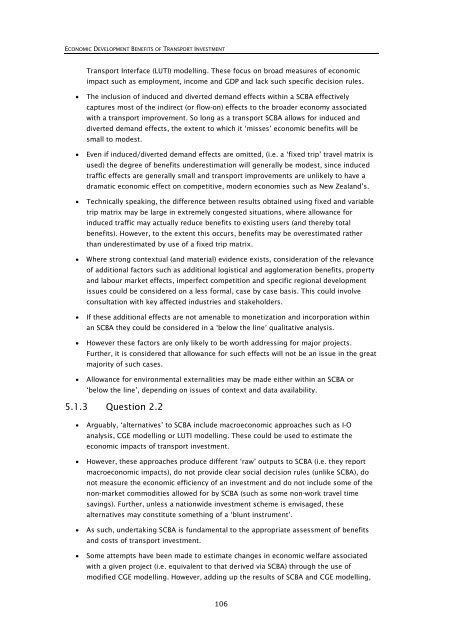Research 350 - NZ Transport Agency
Research 350 - NZ Transport Agency
Research 350 - NZ Transport Agency
You also want an ePaper? Increase the reach of your titles
YUMPU automatically turns print PDFs into web optimized ePapers that Google loves.
ECONOMIC DEVELOPMENT BENEFITS OF TRANSPORT INVESTMENT<br />
<strong>Transport</strong> Interface (LUTI) modelling. These focus on broad measures of economic<br />
impact such as employment, income and GDP and lack such specific decision rules.<br />
• The inclusion of induced and diverted demand effects within a SCBA effectively<br />
captures most of the indirect (or flow-on) effects to the broader economy associated<br />
with a transport improvement. So long as a transport SCBA allows for induced and<br />
diverted demand effects, the extent to which it ‘misses’ economic benefits will be<br />
small to modest.<br />
• Even if induced/diverted demand effects are omitted, (i.e. a ‘fixed trip’ travel matrix is<br />
used) the degree of benefits underestimation will generally be modest, since induced<br />
traffic effects are generally small and transport improvements are unlikely to have a<br />
dramatic economic effect on competitive, modern economies such as New Zealand’s.<br />
• Technically speaking, the difference between results obtained using fixed and variable<br />
trip matrix may be large in extremely congested situations, where allowance for<br />
induced traffic may actually reduce benefits to existing users (and thereby total<br />
benefits). However, to the extent this occurs, benefits may be overestimated rather<br />
than underestimated by use of a fixed trip matrix.<br />
• Where strong contextual (and material) evidence exists, consideration of the relevance<br />
of additional factors such as additional logistical and agglomeration benefits, property<br />
and labour market effects, imperfect competition and specific regional development<br />
issues could be considered on a less formal, case by case basis. This could involve<br />
consultation with key affected industries and stakeholders.<br />
• If these additional effects are not amenable to monetization and incorporation within<br />
an SCBA they could be considered in a ‘below the line’ qualitative analysis.<br />
• However these factors are only likely to be worth addressing for major projects.<br />
Further, it is considered that allowance for such effects will not be an issue in the great<br />
majority of such cases.<br />
• Allowance for environmental externalities may be made either within an SCBA or<br />
‘below the line’, depending on issues of context and data availability.<br />
5.1.3 Question 2.2<br />
• Arguably, ‘alternatives’ to SCBA include macroeconomic approaches such as I-O<br />
analysis, CGE modelling or LUTI modelling. These could be used to estimate the<br />
economic impacts of transport investment.<br />
• However, these approaches produce different ‘raw’ outputs to SCBA (i.e. they report<br />
macroeconomic impacts), do not provide clear social decision rules (unlike SCBA), do<br />
not measure the economic efficiency of an investment and do not include some of the<br />
non-market commodities allowed for by SCBA (such as some non-work travel time<br />
savings). Further, unless a nationwide investment scheme is envisaged, these<br />
alternatives may constitute something of a ‘blunt instrument’.<br />
• As such, undertaking SCBA is fundamental to the appropriate assessment of benefits<br />
and costs of transport investment.<br />
• Some attempts have been made to estimate changes in economic welfare associated<br />
with a given project (i.e. equivalent to that derived via SCBA) through the use of<br />
modified CGE modelling. However, adding up the results of SCBA and CGE modelling,<br />
106
















